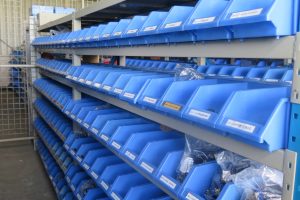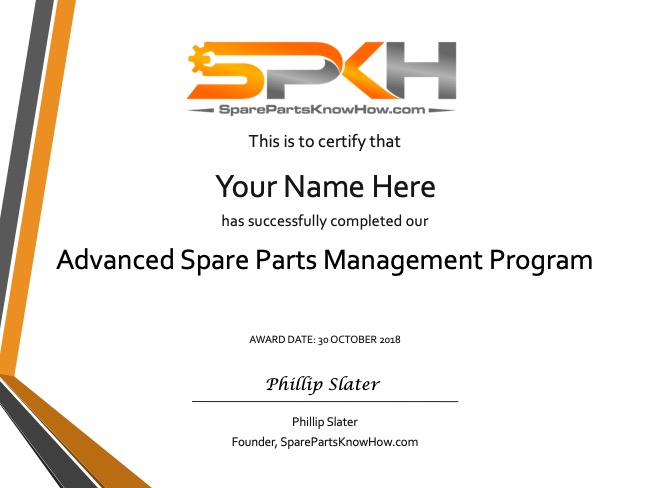 Does your spare parts management process let you down?
Does your spare parts management process let you down?
By that I mean, are there times when the parts you need are not available?
Perhaps resulting in unwanted downtime, additional expediting costs, and wasted labor.
Or are you overstocked with some parts?
Meaning that the company has spent more cash that it really needed to.
Maybe you experience high levels of obsolete parts, indicating both unnecessary expenditure and poor process management.
Maybe parts are stored in a manner that reduces their functional life.
These are all examples of failures that are commonly experienced with spare parts inventory.
One reason, and perhaps even the key reason, that these failures are so common is that, while spare parts inventory management is a complex process that involves a long chain of events, most companies think of spare parts only in the short term.
The thinking is mostly about the here and now.
It is thinking that is task orientated rather than outcome oriented.
No doubt, there are important tasks (think procurement, maintenance, storeroom management) but, in isolation, they rarely focus on the overall outcome. The real ‘big picture’.
Spare parts inventory management is crucial for any organization that relies on equipment to operate.
It might help to think of the inventory of spare parts as a form of insurance policy that mitigates the risks of losses largely due to production interruptions but also safety incidents and unwanted environmental releases.
Of course, there may also be the subsequent impact on business reputation.
The right amount of stock is necessary to ensure that the organization can continue to operate without any disruptions.
However, having every single part in adequate quantities to ensure no possible stock-outs ever is overly expensive and is operationally inefficient.
Therefore, the big picture of spare parts management is to be able to meet the operational demands of the organization without unduly impacting the financial resources of the organization.
This cannot be achieved by focusing on tasks because tasks are what happens within silos. And silos rarely see beyond their own purpose.
Let’s explore that a little.
The long chain of spare parts management events that results in the spare parts that are on your shelves probably starts with the design of the equipment you use.
For most companies this is outside of their control, so let’s not go quite that far back.
But one milestone that is most definitely within the control of your company is the adoption of a stocking policy on when to stock a part and how many to stock.
Whether that stocking policy is formal or informal (read: non-existent) there is still a policy.
If a company doesn’t formalize the stocking policy and just let’s the team ‘wing it’, that is, in effect, a policy.
If there is a formal stocking policy but it is not followed, then not following the policy is, in effect, the policy.
If the stocking policy is limited and doesn’t cover, for example, first time buy, then that is a policy to let the people managing first time buy to ‘wing it’.
So, even if you have deliberately developed a stocking policy, whatever you allow to happen actually becomes your policy.
Let’s look at the long list of other events that are associated with, or follow, the stocking policy milestone.
Here is just a sample (and no doubt you will think of items not included):
- The selection of inventory management software.
- The choice of an ROP/ROQ, Max-Min or ‘Order Up To’, replenishment system.
- The frequency of review for replenishment.
- The choice of how to manage maintenance.
- The budget allocation for resourcing of procurement, storeroom management, planning, and maintenance.
- The decision on metrics and reporting of those metrics.
- The investment in team training so that everyone understands their role in the big picture.
- The investment in the training of individuals in key functions so that they understand the uniqueness of spare parts inventory and can apply best practices.
- The structure of storerooms on large sites and in multi-site organizations.
Note that none of these are really operational tasks.
These are all choices that influence the capacity of the spare parts management system, the ability of the team to manage, the expectations of management and from that, the inventory levels and the investment by the company.
Look at What’s Achievable
Of course, the obvious issue is that, just like the equipment design mentioned above, these choices may have been made long in the past.
Unfortunately, you are now ‘tasked’ with trying to manage within that legacy system.
During my career as a maintenance engineer and later in operations management I made many decisions that changed the way we managed our spare parts inventory.
Readers who are familiar with my background will know that that was when I realized that managing spare parts requires a different approach to other types of inventories.
At that time, I made a choice to change what we did because I worked out that there was a better way.
Individually, those changes were not big, but they did have a big impact.
From a big picture perspective, those changes, along with some others, led to my plant becoming the most profitable in the company.
But that was me, what do you do now?
The first step is to decide if you want to change the situation.
If you do, then start by identifying the things that are most easily addressed.
For example, if the company’s ERP software is unsuitable, changing that quickly is unlikely.
However, training the team is achievable.
Then having that team develop a new stocking policy is achievable.
Implementing that policy is achievable.
Developing and reporting appropriate metrics is achievable.
These are all ‘high impact’ actions that require little in terms of resources.
When you recognize that the decisions being made today are the result of a long chain of spare parts management events, you can also recognize that those past decisions can be changed.
And that is how you can ensure that your spare parts inventory is able to meet the operational demands of your organization without unduly impacting the financial resources of the organization.
Study at a pace and place that suits you
 The Advanced Spare Parts Management Course covers all the issues faced during the spare parts inventory management lifecycle.
The Advanced Spare Parts Management Course covers all the issues faced during the spare parts inventory management lifecycle.
Completing this course equips you with the know-how and skills to effectively manage all aspects of spare parts inventory.
The course specifically focusses on MRO and spare parts that are held in support of equipment operations and maintenance.
Posted by Phillip Slater